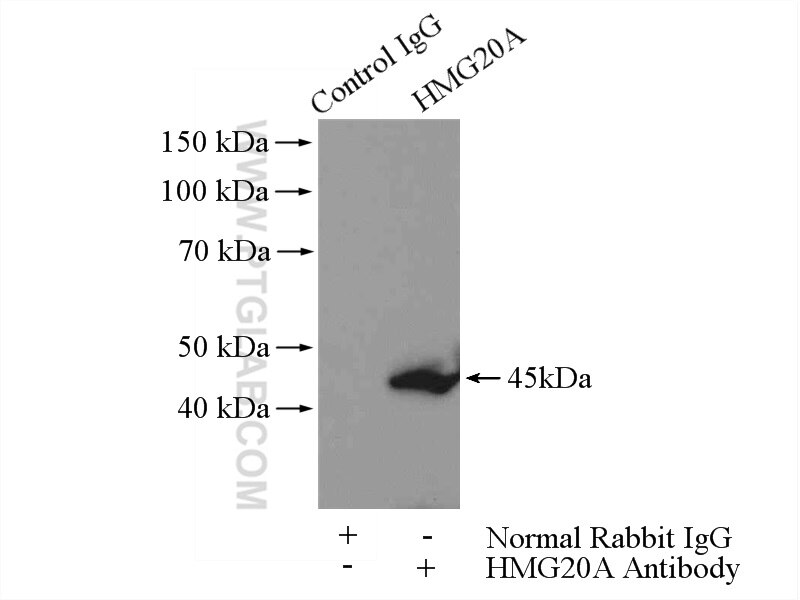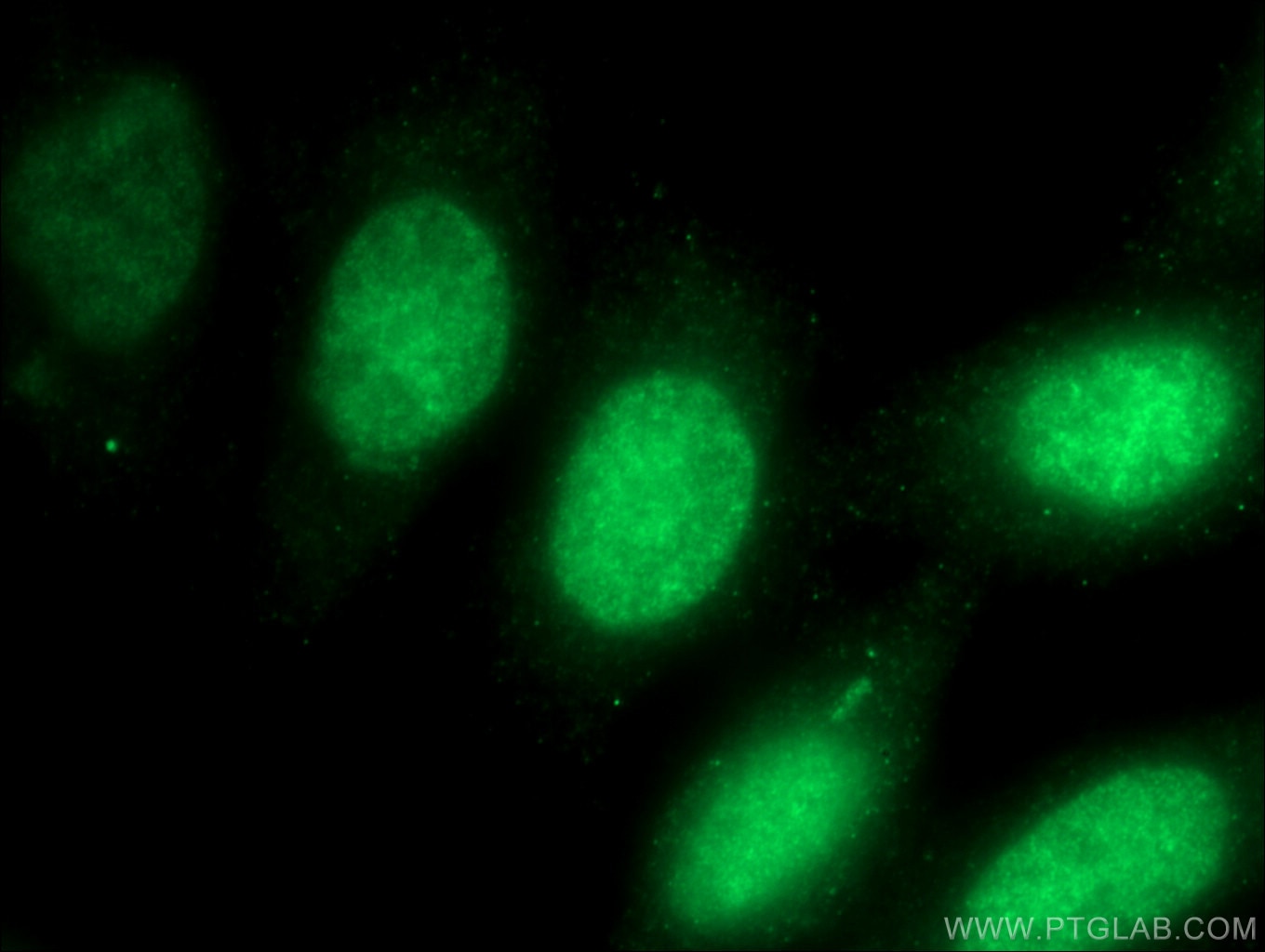- Featured Product
- KD/KO Validated
HMG20A Polyklonaler Antikörper
HMG20A Polyklonal Antikörper für WB, IHC, IF/ICC, IP, ELISA
Wirt / Isotyp
Kaninchen / IgG
Getestete Reaktivität
human, Maus, Ratte
Anwendung
WB, IHC, IF/ICC, IP, CoIP, ELISA
Konjugation
Unkonjugiert
Kat-Nr. : 12085-2-AP
Synonyme
Galerie der Validierungsdaten
Geprüfte Anwendungen
| Erfolgreiche Detektion in WB | Jurkat-Zellen, HEK-293-Zellen |
| Erfolgreiche IP | Jurkat-Zellen |
| Erfolgreiche Detektion in IHC | humanes Pankreaskarzinomgewebe Hinweis: Antigendemaskierung mit TE-Puffer pH 9,0 empfohlen. (*) Wahlweise kann die Antigendemaskierung auch mit Citratpuffer pH 6,0 erfolgen. |
| Erfolgreiche Detektion in IF/ICC | HepG2-Zellen |
Empfohlene Verdünnung
| Anwendung | Verdünnung |
|---|---|
| Western Blot (WB) | WB : 1:500-1:2000 |
| Immunpräzipitation (IP) | IP : 0.5-4.0 ug for 1.0-3.0 mg of total protein lysate |
| Immunhistochemie (IHC) | IHC : 1:20-1:200 |
| Immunfluoreszenz (IF)/ICC | IF/ICC : 1:50-1:500 |
| It is recommended that this reagent should be titrated in each testing system to obtain optimal results. | |
| Sample-dependent, check data in validation data gallery | |
Veröffentlichte Anwendungen
| KD/KO | See 3 publications below |
| WB | See 10 publications below |
| IHC | See 2 publications below |
| IF | See 3 publications below |
| IP | See 2 publications below |
| CoIP | See 1 publications below |
Produktinformation
12085-2-AP bindet in WB, IHC, IF/ICC, IP, CoIP, ELISA HMG20A und zeigt Reaktivität mit human, Maus, Ratten
| Getestete Reaktivität | human, Maus, Ratte |
| In Publikationen genannte Reaktivität | human, Maus |
| Wirt / Isotyp | Kaninchen / IgG |
| Klonalität | Polyklonal |
| Typ | Antikörper |
| Immunogen | HMG20A fusion protein Ag2718 |
| Vollständiger Name | high-mobility group 20A |
| Berechnetes Molekulargewicht | 347 aa, 40 kDa |
| Beobachtetes Molekulargewicht | 45-50 kDa |
| GenBank-Zugangsnummer | BC021959 |
| Gene symbol | HMG20A |
| Gene ID (NCBI) | 10363 |
| Konjugation | Unkonjugiert |
| Form | Liquid |
| Reinigungsmethode | Antigen-Affinitätsreinigung |
| Lagerungspuffer | PBS mit 0.02% Natriumazid und 50% Glycerin pH 7.3. |
| Lagerungsbedingungen | Bei -20°C lagern. Nach dem Versand ein Jahr lang stabil Aliquotieren ist bei -20oC Lagerung nicht notwendig. 20ul Größen enthalten 0,1% BSA. |
Hintergrundinformationen
The HMG (high mobility group) proteins are nonhistone chromosomal proteins that is present in almost all eukaryotic cells, and it functions to stabilize nucleosome formation and acts as a transcription-factor-like protein that regulates the expression of several genes. HMG20A has a role in the initiation of neuronal differentiation by activating REST-responsive genes, and it also nvolves in the recruitment of the histone methyltransferase MLL and consequent increased methylation of histone H3 lysine 4. HMG20A (for inhibitor of BRAF35) overcomes the repressive effects of the neuronal silencer REST and activates REST-responsive genes through the modulation of histone methylation
Protokolle
| Produktspezifische Protokolle | |
|---|---|
| WB protocol for HMG20A antibody 12085-2-AP | Protokoll herunterladen |
| IHC protocol for HMG20A antibody 12085-2-AP | Protokoll herunterladen |
| IF protocol for HMG20A antibody 12085-2-AP | Protokoll herunterladen |
| IP protocol for HMG20A antibody 12085-2-AP | Protokoll herunterladen |
| Standard-Protokolle | |
|---|---|
| Klicken Sie hier, um unsere Standardprotokolle anzuzeigen |
Publikationen
| Species | Application | Title |
|---|---|---|
Nat Commun The H2A.Z and NuRD associated protein HMG20A controls early head and heart developmental transcription programs
| ||
Nat Commun KMT2A associates with PHF5A-PHF14-HMG20A-RAI1 subcomplex in pancreatic cancer stem cells and epigenetically regulates their characteristics | ||
EMBO Mol Med LSD1 inhibition induces differentiation and cell death in Merkel cell carcinoma. | ||
Cancer Cell Int Circular RNA ABCB10 promotes hepatocellular carcinoma progression by increasing HMG20A expression by sponging miR-670-3p. | ||
Biochim Biophys Acta Interactome of the inhibitory isoform of the nuclear transporter Importin 13. | ||
Biochim Biophys Acta The BRCA1-binding protein BRAP2 can act as a cytoplasmic retention factor for nuclear and nuclear envelope-localizing testicular proteins. |











